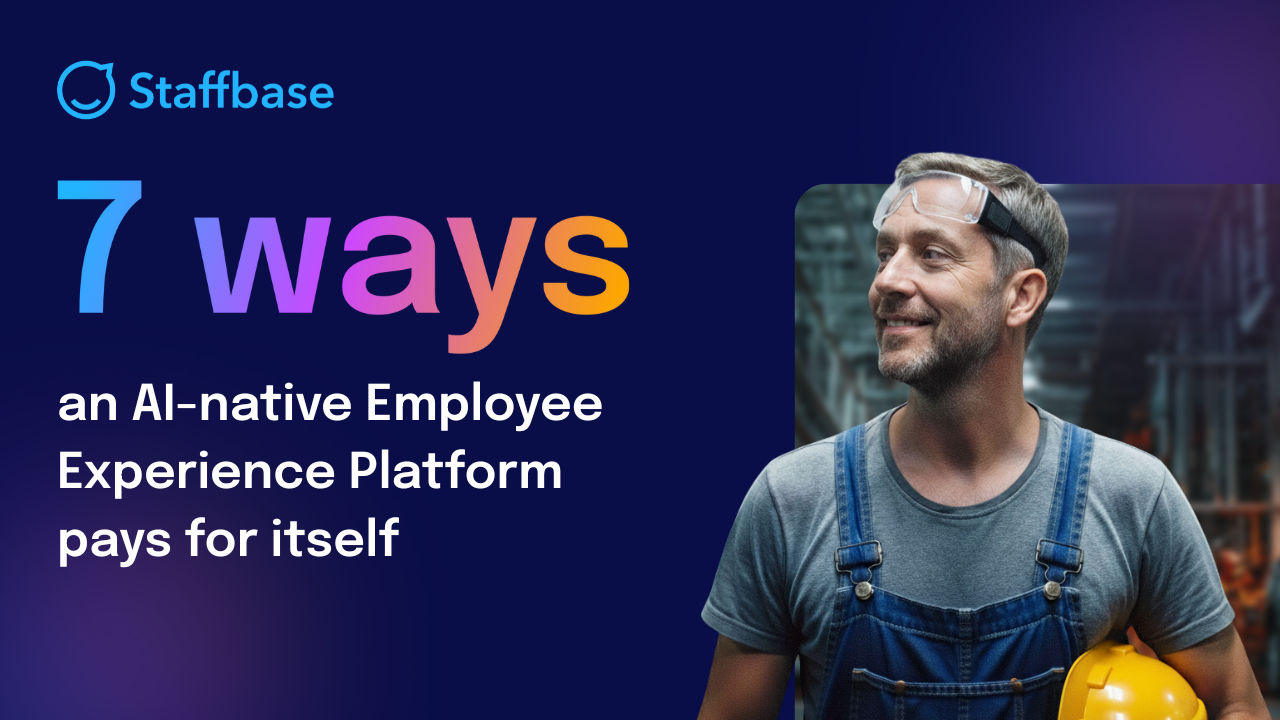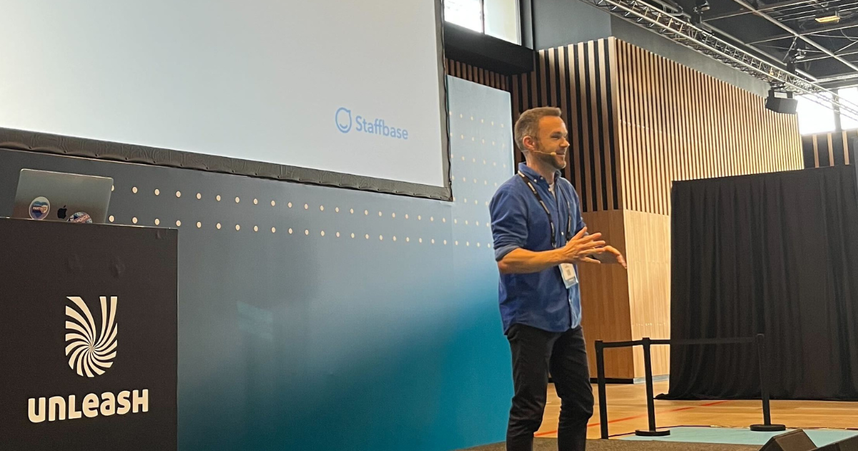7 ways an AI-native employee experience platform pays for itself
Discover 7 ways that an AI-native employee experience platform pays for itself.

It’s an internal comms catch-22. How can you prove that an employee experience platform is worth the investment until you actually start using one?
Most AI tools stall at the desktop. They never reach the people doing the work. But an AI-native employee experience changes that. It connects every employee — from headquarters to the frontline — through trusted channels like the app, intranet, SMS, and email. AI then works behind the scenes to summarize, translate, and nudge in real time, making every message clearer and more actionable.
Here are seven proven ways an AI-native employee experience platform pays for itself — fast.
1. Employee experience platforms reduce risk

Did you know that 2.8 out of 100 workers in the US are injured in workplace accidents every year?
Source, U.S. Bureau of Labor Statistics
Work accidents consume resources, including time and money. They often happen because of weak safety culture and noncompliance — both symptoms of poor operational communication.
In 2023, U.S. employers spent $176.5 billion on work injuries, up from 2020, resulting in 103 million lost workdays, according to National Safety Council reports.
A mobile-first intranet helps leaders share job-critical information and training to ensure compliance. Mobile apps make safety communication faster and more accessible by delivering updates directly to frontline employees wherever they work. This visibility can significantly reduce incident rates and the annual costs of occupational injuries and illnesses.
An AI-native employee experience platform takes it further. It personalizes updates so employees see only what’s relevant to their roles — helping them focus on information that keeps them safe and productive.
With Agentic Content Governance, outdated or duplicate policies are flagged before they reach employees. Owners are prompted to update them, and the right revisions are automatically distributed to the right teams. With accurate, in-the-flow guidance, compliance improves and incidents fall.
2. Employee experience platforms improve customer satisfaction

Did you know that 86 percent of consumers will leave a brand they trusted after only two poor customer experiences?
Source, Businesswire
Customer satisfaction depends on how well organizations equip employees to deliver great experiences. When communication fails, service quality drops — and so does loyalty. Forbes reports that the true cost of bad customer experiences annually can hover around the global number of 3.7 trillion USD.
A mobile-first employee experience platform helps leaders close that gap. It enables them to recognize great work, deliver targeted feedback, and share product updates and service materials that help employees act consistently with company values.
AI makes it even more effective. An AI-native intranet delivers role-specific information — from specs to promotions — so frontline teams always have quick, accurate answers. Leaders can also send personalized recognition and feedback directly through the channels their teams already use. The result: smoother service, stronger loyalty, and measurable gains in customer satisfaction and revenue.
3. Employee experience platforms increase revenue by reducing wasted time

Did you know that when company knowledge is searchable through internal messaging, employees spend up to 35% less time hunting for information?
Source, McKinsey & Company
Employee experience platforms that include self-service tools — such as timesheets, vacation requests, and shift scheduling — dramatically cut down on administrative tasks, especially for non-desk employees without regular computer access. They can also embed onboarding and training materials through checklists and videos, helping new hires ramp up faster and ensuring ongoing learning is simple and accessible.
When employees spend less time searching for information, they have more time for productive work. A multi-channel communications platform can reduce time spent on admin and information hunting by up to 35%, driving a measurable increase in revenue per employee, according to a McKinsey & Company Study.
An AI-native intranet takes this a step further. It acts as a customized assistant for every employee — pulling from approved sources, summarizing key information, and triggering next steps for tasks like timesheets, travel, or policy updates. One conversational entry point means less friction, faster workflows, and more time spent on work that drives growth.
4. Employee experience platforms limit your reliance on email

Did you know that you’re paying every 1,000 employees approximately $415,000 to read your email annually?
Source, Loughborough University Computer Science Department Study
Email remains a popular method for reaching employees. However, every time an employee sees an email in their inbox, it takes time for them to return to focused work. One study found that the average interruption time per employee per email is 64 seconds. If you send 20 administrative and news emails per week, that’s around 21 minutes a week per employee.
That means for every 1,000 employees in your organization, that’s more than 350 hours per week. If your organization pays average wages for the US, that means you’re paying every 1,000 employees approximately $415,000 to read your email annually.
Multichannel comms solutions can target the timing and pertinence of information sharing, significantly cutting time wasted on irrelevant communication. With AI Routing, the platform can schedule and format messages by role and urgency, as well as push SMS messaging when it’s critical. Employees see less noise and more of what matters.
5. Employee experience platforms save cost on employee retention

Did you know that highly engaged employees are significantly less likely to leave their employer, but 63% of employees considering leaving their jobs cite communication as a leading factor?
Source, Staffbase & YouGov 2025 Employee Communications Impact Study
Employee engagement is driven by several factors, including recognition, purpose and goal alignment, strong leadership communication of business goals, and the ability of employees to give feedback. All of these factors can be well addressed with an employee communications management platform.
Our recent study shows the link between clear comms and staying power. Our 2025 International Employee Communications Impact Study found that when employees rated the communication “Excellent,” 76% say they are “very likely” to stay with their company, with an additional 14% reporting being “somewhat likely.”
On the other hand, when the employees rate the communication as “Poor,” only 20% say they are “very likely” to stay with their company, and 13% are “somewhat likely.” The conclusion? Highly engaged employees are significantly less likely to leave their employer. So it's worth investing in good communication.
Employee AI helps managers communicate like humans at scale — translated, tone‑matched, and timely — while Sentiment Analysis surfaces hotspots early. The result: fewer surprises, more reasons to stay.
6. Employee experience platforms save on recruiting costs

Did you know that employees who are not engaged cost their company the equivalent of 18% of their annual salary?
Source, Gallup
Gallup research shows that productivity among highly engaged teams is 14% higher than that of teams with the lowest engagement — and that employees who are not engaged cost their company the equivalent of 18% of their annual salary. Let's look at their example: In a 10,000-person company with an average salary of $50,000, that translates to over $60 million in lost productivity every year.
Reducing disengagement is one of the fastest ways to cut hidden costs in the employee experience — including recruiting. When communication and engagement improve, fewer employees leave, and organizations spend less time filling open roles.
An employee experience platform helps here by keeping teams informed, connected, and recognized. Clear communication builds belonging, while mobile access ensures every employee — especially on the frontline — stays aligned with company goals and culture.
AI makes this even easier. An AI-native platform can analyze engagement patterns, flag potential turnover risks early, and recommend targeted recognition or feedback campaigns before teams start to disengage. That means fewer resignations, lower recruiting costs, and a stronger employer brand that attracts talent organically.
7. Employee experience platforms lower the costs of change processes

Did you know that companies that actively accompany changes with change management programs achieve project ROIs of 143%?
Source, McKinsey & Company
Strong communication is one of the most crucial factors in enabling success during organizational change. Studies report that companies with excellent organizational change management (OCM) programs achieve project ROIs of 143%.
A key driver of OCM success is organization-wide understanding and buy-in for the change — not only at the leadership level but throughout the entire organization.
Involving employees in the change process allows them to understand and accept change. Providing the opportunity for feedback and exchange is a big part of this involvement. Fortunately, feedback is made easy and accessible through mobile intranet features like surveys and polls, as well as acknowledging and commenting on articles and documents.
How can AI tools assist? Agentic Governance keeps project content current, and Sentiment Analysis flags where messages aren’t landing so managers can follow up. You spend less time firefighting and more time moving forward.
Closing words for proving the ROI
Are you ready to prove the ROI of your comms with Staffbase's AI-native Employee Experience Platform? We’ll show you how to take your internal comms to the next level with the power of AI.



